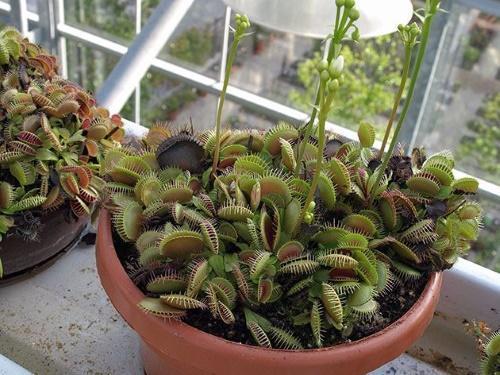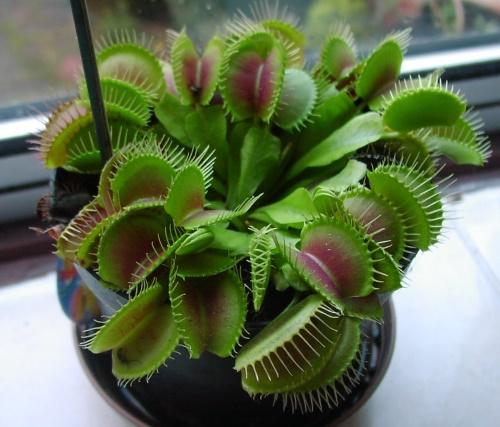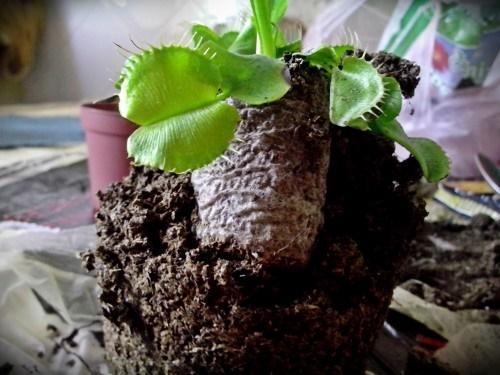How to care for a flycatcher at home - growing a green predator
 If in our time you will not surprise anyone with pelargoniums and anthuriums, then not everyone has predatory plants like the flycatcher. They look really a bit scary, especially during the "hunt". The open traps resemble a toothy mouth awaiting their prey. Unpretentious in natural conditions, flycatchers, when grown as a room culture, need a special approach. If you risk getting yourself this miniature predator, get ready to please him and fulfill all the whims. And the flower has a lot of them, ranging from the conditions of detention, soil and ending with a specific diet. So, today we have an interesting topic - how to care for a flycatcher at home.
If in our time you will not surprise anyone with pelargoniums and anthuriums, then not everyone has predatory plants like the flycatcher. They look really a bit scary, especially during the "hunt". The open traps resemble a toothy mouth awaiting their prey. Unpretentious in natural conditions, flycatchers, when grown as a room culture, need a special approach. If you risk getting yourself this miniature predator, get ready to please him and fulfill all the whims. And the flower has a lot of them, ranging from the conditions of detention, soil and ending with a specific diet. So, today we have an interesting topic - how to care for a flycatcher at home.
The flower is often called the Venus flytrap. In scientific literature, he is also known as Dionea.
Features of plant conditions

Interestingly, it is impossible to constantly turn the pot towards the sun in order to form an even bush. The flower does not like this and may even disappear.
Compliance with the temperature regime is no less important. In the spring-summer period, the plant even tolerates heat well, but in winter it needs a pronounced rest period. For about 4 months, the flycatcher "sleeps" and during this time the pot must be placed in a cool room with a temperature of no more than 7 ° C heat.
What kind of soil does a flycatcher need?
 Originally from swamps, this predator does not need ordinary land and will even disappear. You need to plant a flycatcher in a mixture of peat and sand. Wherein peat should be acidic, and the sand should be quartz. A layer of moss should be laid on top of the substrate to maintain moisture.
Originally from swamps, this predator does not need ordinary land and will even disappear. You need to plant a flycatcher in a mixture of peat and sand. Wherein peat should be acidic, and the sand should be quartz. A layer of moss should be laid on top of the substrate to maintain moisture.
It is better to choose a flower pot that is light, not very wide, up to 12 cm in diameter, but twice as deep. The presence of drainage holes and a pallet is required, but the drainage does not need to be laid.
How to care for a flycatcher at home: important nuances of healthy flower development
 In order to preserve the plant and protect it from diseases, care recommendations should be followed exactly, namely:
In order to preserve the plant and protect it from diseases, care recommendations should be followed exactly, namely:
- Water the flower strictly in the pan, often, but in small portions. Water must be used rainwater, previously settled, and added every 2-3 days.
- Periodically add formic acid to the water when watering.
- Maintain air humidity by spraying the bush in the heat.
Particular attention should be paid to feeding the flycatcher. It does not need fertilizers, since small insects serve as food for the plant.If you take a flower out into the garden for the summer, it will catch them on its own. But with room maintenance, you will have to prepare and feed the flycatcher "artificially".
Dionea feeds not only flies, but also spiders, ants and other insects. The main thing is that they are alive, the size does not exceed 1/3 of the size of the trap, and the shell is not hard.
 The flycatcher is not particularly gluttonous, but nevertheless, one fly every 2 weeks should be put in a couple of traps. Next time, the insects are fed to other traps, observing the order. With the onset of the dormant period, feeding is stopped, only occasionally moistening the substrate.
The flycatcher is not particularly gluttonous, but nevertheless, one fly every 2 weeks should be put in a couple of traps. Next time, the insects are fed to other traps, observing the order. With the onset of the dormant period, feeding is stopped, only occasionally moistening the substrate.